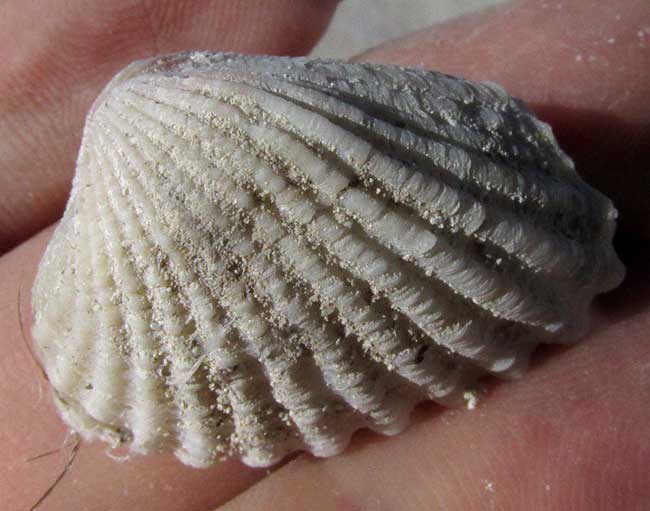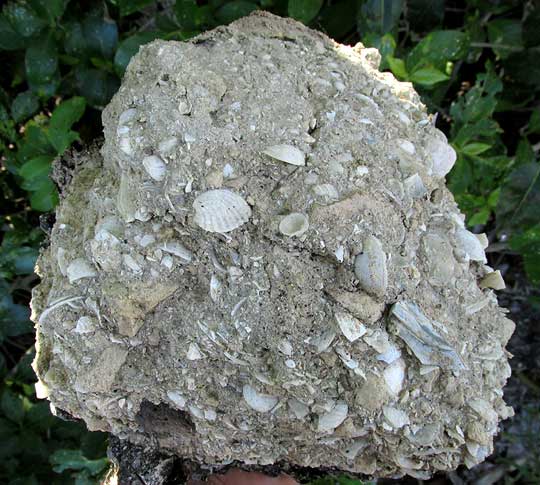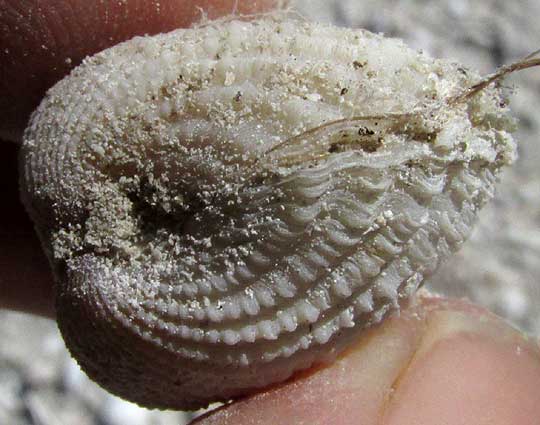Excerpts from Jim Conrad's
Naturalist Newsletter

from the January 11, 2015 Newsletter issued from Río Lagartos, on the Yucatan Peninsula's northern coast (~N21.60°, ~W88.16°), Yucatán state, MÉXICO
PRICKLY COCKLE FOSSIL
Salt-producing ponds at Las Coloradas just east of Río Lagartos occupy about 6900 acres (2800has). The ponds are separated from one another by narrow levees sometimes topped with one-lane dirt roads. It's good birding out there and with all that glaring sunlight, wind and blowing foam it's a dramatic landscape, but getting disoriented on those levee-top roads is a problem. The levees have been built with backhoes, using fill material from adjoining pond bottoms. The fill material mostly is loose and unconsolidated but inside it are many fair-size, white coagulations of cemented-together sand, mud and mollusk shells, such as what's shown below:

Though with a pen knife or even a fingernail usually you can drill a hole in these coagulations, they're hard enough to be called rocks. A few more millennia of compression by sedimentation above them, and continued chemical bonding of the kind that hardens concrete, might produce rock that without hesitation could be called limestone. This is limestone in its earliest state of formation.
Even the sand and mud forming this rock's matrix consist mostly of tiny seashells and seashell fragments. Normally seashells embedded in rocks are called fossils, so the question arises as to whether the seashells in these coagulations-becoming-rocks also are fossils. The term fossil is defined as "A remnant or trace of an organism of a past geologic age embedded and preserved in the earth's crust." Do the organism traces -- the shells -- in these incipient rocks come from a past geologic age?
The subdivision of geologic time beginning about 11,700 years ago at the end of the last Ice Age, or the Pleistocene Epoch, and lasting until now, is referred to as the Holocene Epoch, and the literature is full of references to Holocene fossils. Therefore, I'm calling mollusk shells teased from these very young rocks fossils, and I'm curious as to whether any fossil in them has members of the same species living in the ocean lying just across a narrow band of sand dunes from the salt ponds.
One such fossil pried from a rock with a stick and my fingernails is shown at the top of this page. That's a top view. Below, you can see the same shell from behind:

The fossil consists of two shells, each shell the mirror image of the other, and you can visualize that when the mollusk was alive the two shells could be opened by hinging at the point on the back where the two tooth-like projections meet. A side view is shown below:

Though time seems to have bleached color from the shell, we can still see fine details enabling this shell to be identified. Specifically, near the bottom of the shell, notice that the warty projections are sharply pointed on top, but become blunt both behind and in front. At the front of the shell, the warts become scoop-shaped, with the scoop openings facing forward.
These are features of the Yellow Prickly Cockle, DALLOCARDIA MURICATA, in older literature referred to as Trachycardium muricatum. Yellow Prickly Cockles are commonly found living today from North Carolina on the US Atlantic coast, south through the Gulf of Mexico and Caribbean and all the way to Brazil. Confidence in the name is increased by the species being one of several identified by experts found during archaeological excavations of the Southern Plaza of the ruins of Dzibilchaltún, about 17kms north of Mérida in northwestern Yucatán. The interesting 2004 paper listing it and other finds, by Gloria Santiago Lastra, is entitled "La Plaza Sur de Dzibilchaltún, Yucatán," and is freely downloadable on the Internet in PDF format at http://www.famsi.org/reports/00006es/00006esSantiagoLastra01.pdf.
Though I find no other species better matching our fossil than those labeled Dallocardia muricata, to me our fossil seems slightly different. Its ridges are slightly less numerous and thicker than those shown on the Internet. Is this because our fossil is several centuries or millennia old, from a time when the ancestors of today's Dallocardia muricata grew shells with fewer and thicker ridges?
I like to think that that's the case, but who knows? Whatever the situation, this little bean-size fossil found among the salt pans gave me the gift of several hours of sleuthing and learning and generally continuing to ploddingly get things figured out.